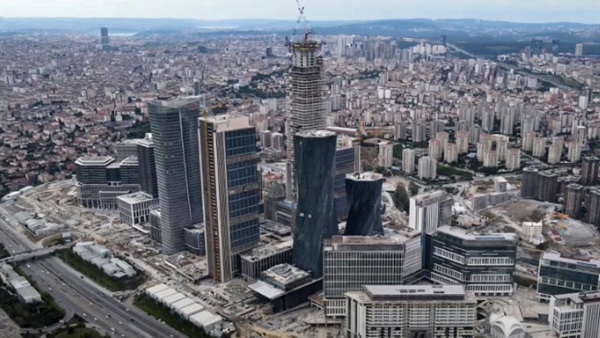How Erdogan’s ‘Canary Wharf of Turkey’ became symbol of decline

On the side of a six-lane highway in Istanbul, a gleaming set of new skyscrapers rises through car fumes. One is a twisting column of glass and steel with aesthetic echoes of the Gherkin, and another is fluted like a Turkish teacup. The tallest of the towers is topped with a modernist turret and, like all new state-funded developments in Turkey, there is a mosque.
The Istanbul Finance Centre (IFC) was conceived a decade ago to be the Canary Wharf of Turkey: a purpose-built money district away from the overcrowded city centre, where banks, state financial institutions and foreign investors would gather. Covering 300,000 square metres on the Anatolian side of Istanbul, it includes a shopping centre, conference hall and five-star hotel, with small green areas nestling between the 50-storey towers. It also boasts 26,500 parking spaces — the IFC is easily accessible only by car, as I discovered when I tried to reach it by public transport on a recent drizzly afternoon.
From the nearest metro station I walked for 45 minutes through soulless expanses of gated tower block residences, punctuated by huge shopping centres. Sometimes I had to walk along the edges of churning dual carriageways, sprinting across in front of oncoming traffic. I encountered almost no one else on the pavements. All the while I could see the huge towers of the IFC straight in front of me but when I reached the final road between us, the huge E5 highway, there was no way I could cross it. This was urban planning torn up and thrown to the wind.
Land for the project was re-zoned by President Erdogan’s government, taking it from Atasehir, a middle-class district controlled by the opposition CHP, and handing it to neighbouring Umraniye, a working-class, conservative borough and a stronghold of Erdogan’s AKP. When ground was broken in 2012, Turkey was riding the end of an astounding economic boom, partly the result of a decade of cheap credit. Five years on, construction of the IFC stalled as the lira lost value and growth stuttered. In 2019 the project was handed to Turkey’s sovereign wealth fund, which contracted real estate agents and contractors with close ties to Erdogan to finish the work.
Regulations issued in July handed huge tax breaks and employment benefits to companies based in the IFC. Turkey’s central bank, capital markets board and the Istanbul stock exchange will be based there. As the IFC prepares to open, however, Turkey’s economy is in crisis. The lira is worth a sixth against the dollar of what it was in 2012, and foreign direct investment has plunged by a third in the same period. The state-owned Halkbank, which will occupy one of the tallest towers, is embroiled in allegations of Iranian sanctions-busting, and US prosecutors have filed an indictment against it in New York. Erdogan has tightened his grip over the once-independent central bank, overruling technocrats’ attempts to raise the interest base rate and cool the overheated economy, while compelling private banks to keep lending. Property and stock prices have ballooned this year as Turks frantically invest to mitigate the collapsing value of their savings. On Turkish social media the joke goes that this is the “Umraniye Finance Centre”: a symbol not of Turkey’s economic success, but its decline and squander.
Veysel Ulusoy, an economist and director of Turkey’s Inflation Research Group, said: “Foreign investors have been excluded from the market, inflation has risen, and interest rates brought down, with the sole aim of saving the construction sector ... It is clear that the finance centre is a construction project, and a way of handing revenue to several conglomerates.
“Financial centres usually emerge in parallel with natural economic development. Government policies can support this, but there has to be supply and demand. Squeezing a financial centre into a certain geographical area is unnecessary.”
Umraniye itself is a result of Turkey’s economic policies and recent preference for driving growth with construction. Like many urban districts in Turkey, it has developed at warp-speed since the turn of the millennium, morphing from a crime-ridden suburb of informally built apartments into a central city district stuffed with new tower blocks and bisected by major highways.
It is the people living in districts such as these who are now being hit hardest by the downturn. Living standards have soared here but so too have debts, as the new middle class that has emerged during Erdogan’s era takes out mortgages and car loans. With annual inflation at 84.4 per cent according to official figures and 170 per cent according to independent economists, many are forced to use credit cards to cover daily living expenses.
Enes Arslan, 26, who grew up in Umraniye and lives there with his family, said: “With the wage of a white-collar worker you can’t even rent an apartment in Umraniye today. Others who earn minimum wage can barely afford their daily lives.
“Some are spending their entire savings or getting credit in order to pay for their weddings, and newlyweds are loading themselves with debt. The main problem is economic instability and uncertainty.”





